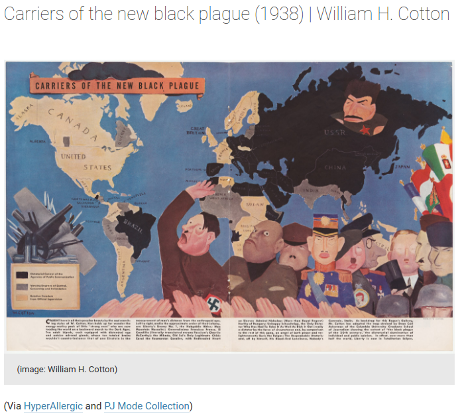Vintage Infodesign [161]: More examples of persuasive cartography, diagrams and charts from before 1960 by Tiago Veloso.
From the post:
A recurrent topic here on Vintage InfoDesign is “persuasive cartography” – the use of maps to influence and in many cases, deceive. We showcased examples of these maps here and here, with a special mention to the PJ Mode Collection at Cornell University Library. The collection was donated to Cornell back in 2014, and until now more than 300 examples are available online in high resolution.
A must for all of those interested in the subject, and we picked a few examples to open this post, courtesy of Allison Meier, who published a rente article about the PJ Mode Collection over at Hyperallergic.
Re-reading The Power of Maps (1992) by Denis Wood, in preparation to read Rethinking The Power of Maps (2010), also by Denis Wood, has made me acutely aware of aspersions such as:
“persuasive cartography” – the use of maps to influence and in many cases, deceive.
I say “aspersion” because Wood makes the case that all maps, with no exceptions, are the results of omissions, characterizations, enhancements, emphasis on some features and not others, for stated and/or unstated purposes.
Indeed, all of The Power of Maps (1992) is devoted to teasing out, with copious examples, where a user of a map may fail to recognize the “truth” of any map, is a social construct in a context shaped by factors known and unknown.
I characterize maps I disagree with as being deceptive, disingenuous, inaccurate, etc., but doesn’t take away from Wood’s central point that all maps are acts of persuasion.
The critical question being: Do you support the persuasion a map is attempting to make?
When I teach topic maps again I will make The Power of Maps (1992) required reading.
It is an important lesson to realize that any map, even a topic map, need only map so much of the territory or domain, as is sufficient for the task at hand.
A topic maps for nuclear physics won’t have much in common with one for war criminals of the George W. Bush and Barack Obama administrations.
Moreover, even topic maps of the same subject domain, may or may not merge in a meaningful way.
The idea of useful merger of arbitrary topic maps, like the idea of “objective maps,” is a false one that serves no useful purpose.
Say rather that topic maps can make enough information explicit about subjects to determine if merging will be meaningful to one or more users of a topic map. That alone is quite a feat.
